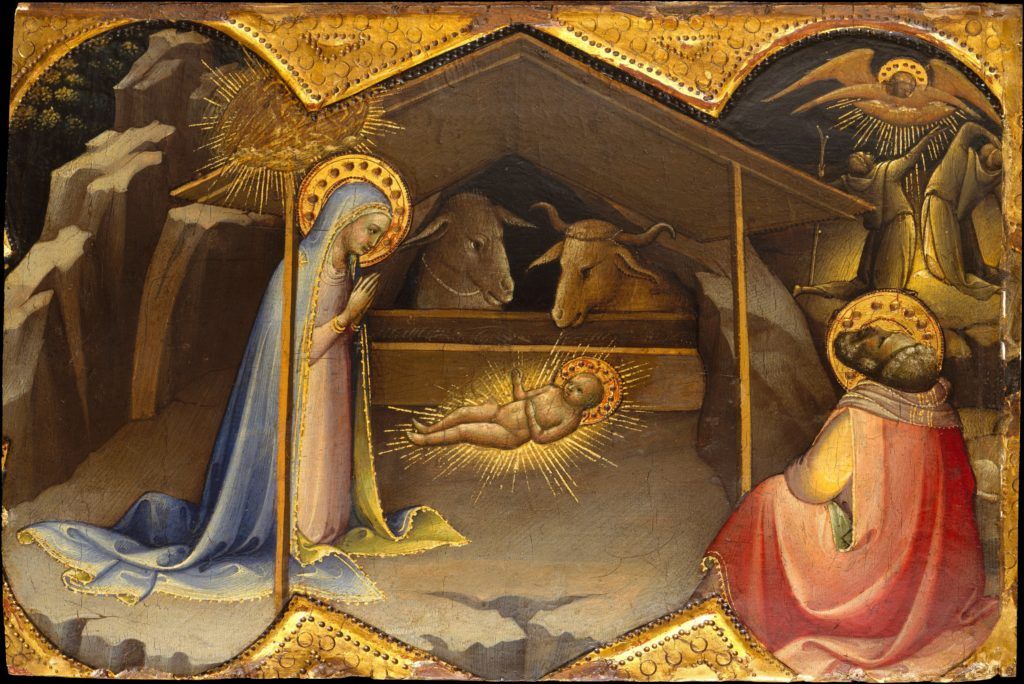[Theme music begins]
Welcome to Harmonia … I’m Angela Mariani. This hour, we celebrate the warmth and light that the Christmas season offers us in the cold and dark of winter. We’ll hear exuberant choral works that express the joy and anticipation surrounding the holidays, as well as pieces that convey the sense of wonder and mystery wrapped up in the miracle of Christmas. Plus, our featured recording is Johann Sebastian Bach’s Christmas Magnificat by RIAS Kammerchor Berlin with the Akademie für Alte Musik Berlin released by Harmonia Mundi in October 2024.
[Theme music fades at :59]
Johann Pachelbel Organ Works
Bernard Lagacé
Arion Music | 3325480511653 (2020)
Johann Pachelbel
Tr. 4 Vom Himmel hoch da komm ich her (4:40)
Bernard Lagacé played two chorale preludes on the tune Vom Himmel hoch, da komm ich her by Johann Pachelbel. The original hymn text, written by Martin Luther in 1534, tells the story of the nativity. It begins:
From heaven above to earth I come
To bear good news to every home;
Glad tidings of great joy I bring
Whereof I now will say and sing:
To you this night is born a child
Of Mary, chosen mother mild;
This little child, of lowly birth,
Shall be the joy of all your earth.
The winter holidays have inspired countless musical works spanning every era of Western music. This hour, we’ll hear music that focuses on the joy and wonder that Christmas brings; it may be the excitement of the biblical story of Jesus’ birth, or perhaps, the anticipation of time with family and friends, [or both]. For whatever the reason, we’re joining the celebration with early music!
Let’s begin with the carol “Gaudete,” which means “Rejoice” in Latin. The carol was first published anonymously in 1582 in a collection called Piae Cantiones, a compilation of sacred songs in northern Europe. The tune is joyful and buoyant, exemplifying the spirit of the text. The refrain begins “Rejoice, rejoice! Christ is born of the Virgin Mary, rejoice!” Each verse expresses joy and admiration for a different aspect of the Christmas story: first for God’s grace, then the immaculate conception, and finally for the salvation that is offered.
Carols from Queen’s
Queen’s College Choir
Avie Records | AV2345 (2015)
Anonymous
Tr. 11 Gaudete [16th Century] (1:26)
The Queen’s College Choir sang “Gaudete,” an anonymous Christmas carol from the sixteenth century.
Dutch organist Jan Sweelinck’s Christmas motet “Hodie Christus Natus Est” captures the wonder and mystery of the miracle of Christmas. The text is taken from an antiphon for Christmas Day and the title means “Today, Christ is born.” The motet alternates between duple and triple meter, symbolizing the rejoicing of the shepherds and angels who witnessed the Christmas miracle.
A Renaissance Christmas
The Sixteen
Coro | COR16167 (2018)
Jan Pieterszoon Sweelinck
Tr. 2 Hodie Christus Natus Est (2:47)
The motet “Hodie Christus Natus Est,” by Jan Sweelinck, sung by The Sixteen.
Next, we’ll hear two settings of the carol “In dulci jubilo,” the text of which dates to the early 14th century and was written by the German mystic Heinrich Seuse. According to legend, Seuse heard angels singing these words, inspiring him to write the text of the carol. The melody first appeared in a manuscript around 1400 and spread across Europe. In English-language hymnals, this carol is known as “Good Christian Friends, Rejoice.”
Michael Praetorius wrote his setting of the carol in 1607. Praetorius arranged the carol for eight voices split between two choirs. His setting captures the joyful and festive spirit through intricate polyphony. Johann Sebastian Bach wrote his harmonization at some point before 1725. It is not as buoyant as Praetorius’s setting but features lush harmony that takes advantage of the wide vocal range of the melody.
Ein Kind ist uns Geboren
Augsburg Cathedral Boys’ Choir, Reinhard Kammler
Ars Musici 2008 | AM232427
Michael Praetorius
Tr. 10 In Dulci Jubilo (2:39)
Christmas: A Cappella Carols and Hymns
The Gesualdo Six
Hyperion | 00602448804891 (2019)
Johann Sebastian Bach
Tr. 18 In dulci jubilo (2:49)
Two settings of the motet “In dulci jubilo,” the first by Michael Praetorius sung by the Augsburg Cathedral Boys’ choir, and the second setting by Johann Sebastian Bach sung by The Gesualdo Six.
The next piece, also reflecting the joy of Christmas, Our final piece that reflects Christmas joy is the motet “Resonet in laudibus” by Orlando Lassus, written in 1569. The title means “Resound in praises,” and the text of the motet details the many reasons to celebrate the birth of the Messiah in Christian theology. Lassus uses the voices in different groupings throughout the motet to simulate different strains echoing amongst choirs of shepherds and angels.
Resonet in laudibus
Niederaltaicher Scholaren
Sony Classical | 886447517901 (1994)
Orlando Lassus
Tr. 2 Resonet in Laudibus (3:50)
The Niederaltaicher Scholars sang the Christmas motet “Resonet in Laudibus” by Orlando Lassus.
You’re listening to Harmonia . . . I’m Angela Mariani.
Christmas Concerti
Capella Istropolitana
Naxos | 8.550567 (1991)
Arcangelo Corelli
Tr. 15 Pastorale ad libitum: Largo (excerpt of 4:11)
[Fade music at :59]
Welcome back. This hour, we’re exploring the ways composers captured the feelings and spirit of the holiday season. We began with pieces expressing the joy and excitement of Christmas. Now, we’ll hear how choral and instrumental works that portray the mystery and wonder of Christmastide.
“O Magnum Mysterium” by Tomas Luis de Victoria is perhaps one of the most famous pieces in the choral repertoire. The text marvels at the humble setting of the nativity, emphasizing the wonder of the animals that were there to witness the newborn baby in the manger. The motet ends with the singers joyfully proclaiming “Alleluia.”
O Magnum Mysterium
Robert Shaw Festival and Chamber Singers
Telarc | 00888072190894 (2000)
Tomas Luis de Victoria
Tr. 4 O Magnum Mysterium (4:06)
The Robert Shaw Chamber Singers performed “O Magnum Mysterium” by Tomas Luis de Victoria.
The motet “Verbum Caro Factum Est” takes its text from the opening of the Gospel of John. The title means “The Word was made flesh” and refers the incarnation—the concept in Christian theology that God literally became human through the birth of Jesus. German composer Hans Leo Hassler composed his setting of “Verbum Caro” in 1591. It alternates between homophonic sections where both choirs sing together, and polyphonic sections where the two choirs sing in opposition to each other. This choral texture reflects the fact that Hassler was a student of Giovanni Gabrieli.
Sacred Treasures of Christmas
The London Oratory Choir
Hyperion | 00602458138979 (2020)
Hans Leo Hassler
Tr. 4 Verbum Caro Factum Est (3:21)
“Verbum Caro Factum Est,” by Hans Leo Hassler, performed by the London Oratory Choir.
Next: the orchestral work “Christmas Concerto,” Op. 6, No. 8, written by Arcangelo Corelli in the late 17th century. The concerto gets its name from an inscription Corelli wrote on the title page: “Fatto per la notte di Natale,” which means “composed for the night of Christmas.” The work features a small group of soloists – in this case two violins and a cello – supported by full string orchestra. The final movement is the “Pastorale ad libitum,” and the gentle, pleasant, lilting character of the pastorale is thought to depict the peacefulness of the Nativity. Composers often used the music style of a pastorale to evoke idyllic and natural landscapes, often associated with shepherds and the countryside.
Christmas Concerti
Capella Istropolitana
Naxos | 8.550567 (1991)
Arcangelo Corelli
Concerto Grosso in G Minor, Op. 6, No. 8, "Christmas Concerto":
Tr. 10 I. Vivace-Grave (1:12)
Tr. 11 II. Allegro (2:00)
Tr. 12 III. Adagio-Allegro-Adagio (3:31)
Tr. 13 IV. Vivace (1:09)
Tr. 15 VI. Pastorale ad libitum: Largo (4:11)
Music from Arcangelo Corelli’s “Christmas Concerto,” ending with the famous pastorale, [“Pastorale ad libitum,”] performed by Capella Istrapolitana.
Our featured release this hour is a recording of Johann Sebastian Bach’s Christmas Magnificat performed by RIAS Kammerchor Berlin and the Akademie für Alte Musik Berlin, directed by Justin Doyle, and released by Harmonia Mundi in October 2024. The text of the Magnificat comes from the Bible story of the Visitation of Mary in the first chapter of Luke. Mary, who has been told by the Angel Gabriel that she is pregnant and will give birth to the Massiah, visits her cousin Elizabeth, who at her advanced age is miraculously pregnant with John the Baptist just as the Angel Gabriel had also predicted. As the story goes, when Mary greets Elizabeth, Elizabeth’s baby moves, as if recognizing his yet-unborn cousin. Elizabeth, filled with the Holy Spirit, proclaims that Mary is blessed beyond all women, and Mary responds with the canticle of praise that has come to be known as the Magnificat.
Bach’s setting of the Magnificat exists in multiple versions, and was used for multiple Marian holidays throughout the year. Its first performance in 1723 was most likely for the feast of the Visitation on its pre-Vatican II date of July 2nd (it is now observed on May 31). At the end of 1723, Bach composed four additional movements to be interpolated into the Magnificat for the Christmas season, which is the version recorded by the RIAS Kammerchor Berlin here.
We’ll hear the opening five movements of the Christmas version of the Magnificat. The third movement, based on the Christmas hymn Vom Himmel hoch, is one of the four interpolations Bach added for performance at Christmas.
J.S. Bach Weihanchts-Magnificat
RIAS Kammerchor Berlin, Akademie für Alte Musik Berlin, Justin Doyle
Harmonia Mundi | 31490252665 (2024)
Johann Sebastian Bach
Magnificat in E-Flat Major, BWV 243.1
Tr. 1 I. Magnificat anima mea (2:46)
Tr. 2 II. Et exsultavit spiritus meus (2:10)
Tr. 3 III. Vom Himmel hoch (1:37)
Tr. 4 IV. Quia respexit
Tr. 5 V. Omnes generationes (3:42)
The RIAS Kammerchor Berlin performed the opening movements of Johann Sebastian Bach’s Christmas Magnificat, including the hymn Bach inserted for performance during the Christmas season: Vom Himmel hoch, da kom ich her.
[Fade in theme music]
Harmonia is a production of WFIU and part of the educational mission of Indiana University.
Support comes from Early Music America: a national organization that advocates and supports the historical performance of music of the past, the community of artists who create it, and the listeners whose lives are enriched by it. On the web at EarlyMusicAmerica-dot-org.
Additional resources come from the William and Gayle Cook Music Library at the Indiana University Jacobs School of Music.
We welcome your thoughts about any part of this program, or about early music in general. Contact us at harmonia early music dot org. You can follow us on Facebook by searching for Harmonia Early Music.
The writer for this edition of Harmonia is Travis Whaley.
Thanks to our studio engineer Michael Paskash, and our production team: LuAnn Johnson, Aaron Cain, and John Bailey. I’m Angela Mariani, inviting you to join us again for the next edition of Harmonia.
[Theme music concludes]










